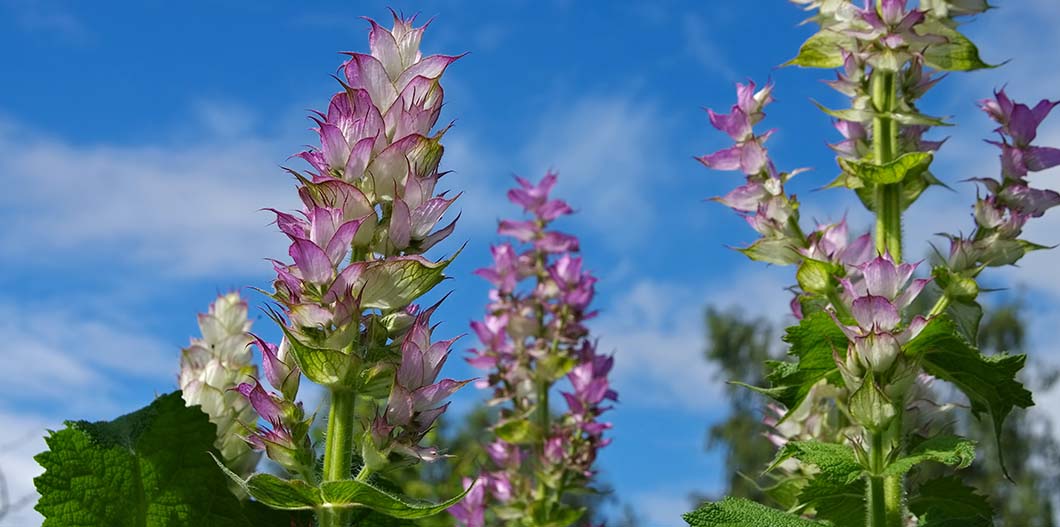Background
Clary sage (Salvia sclarea L.) is a biennial or short-lived perennial member of the mint family. The oil of Clary sage has an odor similar to ambergris and is used in perfumes, soaps, cosmetics, aromatherapy, and as a flavoring, especially for muscatel wines. The plant also has medicinal uses.
Clary sage forms a rosette of large, velvety leaves the first year. The stalks of pink to white flowers produced the second year may be up to 5 ft tall. Fall sown plants will bloom the next year, after vernalization. The plant is adapted to a dry climate and produces more oil under low fertility and moisture. Oil yields of 0.15% (fresh weight basis) were reported from plants growing on poor ground at high altitudes, while yields of only 0.07% were obtained from plants on rich soil (1).
The plant is harvested during late bloom, when the seeds are at the milky stage. Most of the oil is in the flowering stalk, so the plant should be cut to include the inflorescence and only the top few pairs of leaves. The plant material is distilled fresh, and should be distilled immediately to avoid volatilization of the oil. Oil content is lowest from noon to 3:00 pm, so Clary sage should be harvested in the evening or morning hours (2). The oil is rich in linalyl acetate (45-87%) with sclareol, linalool, nerol, beta-pinene, alpha- and beta-thujone, borneol, and a small amount of mircene and camphor (2).
Research Summary
Clary sage (Johnny's Selected Seeds) was sown in the greenhouse April 13, 1998 at the Western Agricultural Research Center, Corvallis, MT. Plants were transplanted to the field May 13, 1998. Six- row plots were 8-ft-long with rows 18 inches apart, in four replications. Plant spacing was initially 1-ft in the row, but in the early spring of 1999 plants were thinned to stand 2 ft apart.
Plant growth was vigorous. Flowering tops were harvested at late bloom on July 21, 1999, as the flowers were fading and the seeds were in the milk stage. Flower stalks with the top pair of leaves were harvested and distilled immediately at the MSU Northwestern Agricultural Research Center, Creston, MT. The plants continued to bloom and plants were again harvested on August 19, 1999. Border rows were not included.
The first harvest resulted in the greatest oil yield, but distillation of the second bloom added significantly to total production. The oil from the two harvests did not differ greatly in quality; oil from the first cutting averaged 64% linalyl acetate, and the second averaged 59%.
|
|
Dry weight (lb/a) ± SE
|
Oil (lb/a) ± SE
|
|---|---|---|
|
Harvest 1
|
3,442 ± 272
|
20.5 ± 2.3
|
|
Harvest 2
|
1,302 ± 154
|
7.2 ± 0.1
|
|
Total
|
4,744
|
27.9
|
Discussion
Clary sage is well adapted to the climate of western Montana. Yield and quality of plants grown at the WARC was high, and the plants were free of pests and diseases. The crop was established from transplants in this trial, but fall direct seeding may also be done. A plant with 5-7 rosette leaves is more resistant to winter injury than are smaller seedlings (2).
Acknowledgements
Seed was donated by Johnny’s Selected Seeds, Albion, ME
Oil analysis was performed by I. P. Callison and Sons, Chehalis, WA; Essex Laboratories,
Inc., Salem, OR; and Wm. Leman Company, Bremen, IN.
References
- Guenther, E. 1950. The Essential Oils. Van Nostrand and Co., Inc., New York.
- Hornok, L. 1992. Chichester, UK. Cultivation and Processing of Medicinal Plants. John Wiley and Sons,
- Lawrence, B. M. 1993. A planning scheme to evaluate new aromatic plants for the flavor and fragrance industries. p. 620-627. In: J. Janick and J. E. Simon (eds.), New Crops. Wiley, New York.
- Simon, J. E., A. F. Chadwick and L. E. Craker. 1984. Herbs: An Indexed Bibliography. 1971- 1980. The Scientific Literature on Selected Herbs, and Aromatic and Medicinal Plants of the Temperate Zone. Archon Books, Hamden, CT.

